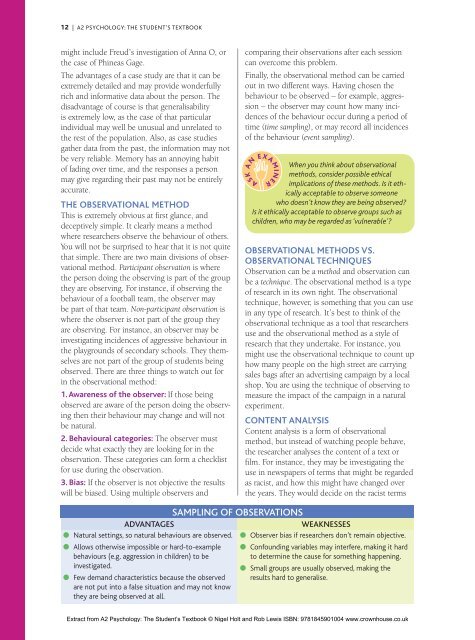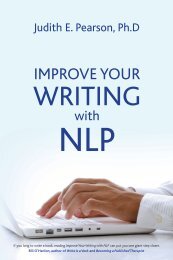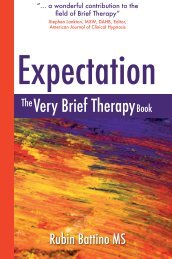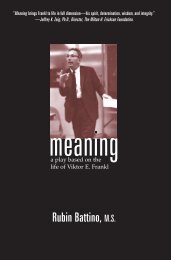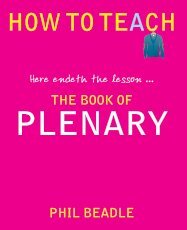Nigel Holt and Rob Lewis - Crown House Publishing.
Nigel Holt and Rob Lewis - Crown House Publishing.
Nigel Holt and Rob Lewis - Crown House Publishing.
Create successful ePaper yourself
Turn your PDF publications into a flip-book with our unique Google optimized e-Paper software.
12 | A2 PSYCHOLOGY: THE STUDENT’S TEXTBOOKmight include Freud’s investigation of Anna O, orthe case of Phineas Gage.The advantages of a case study are that it can beextremely detailed <strong>and</strong> may provide wonderfullyrich <strong>and</strong> informative data about the person. Thedisadvantage of course is that generalisabilityis extremely low, as the case of that particularindividual may well be unusual <strong>and</strong> unrelated tothe rest of the population. Also, as case studiesgather data from the past, the information may notbe very reliable. Memory has an annoying habitof fading over time, <strong>and</strong> the responses a personmay give regarding their past may not be entirelyaccurate.The observational methodThis is extremely obvious at first glance, <strong>and</strong>deceptively simple. It clearly means a methodwhere researchers observe the behaviour of others.You will not be surprised to hear that it is not quitethat simple. There are two main divisions of observationalmethod. Participant observation is wherethe person doing the observing is part of the groupthey are observing. For instance, if observing thebehaviour of a football team, the observer maybe part of that team. Non-participant observation iswhere the observer is not part of the group theyare observing. For instance, an observer may beinvestigating incidences of aggressive behaviour inthe playgrounds of secondary schools. They themselvesare not part of the group of students beingobserved. There are three things to watch out forin the observational method:1. Awareness of the observer: If those beingobserved are aware of the person doing the observingthen their behaviour may change <strong>and</strong> will notbe natural.2. Behavioural categories: The observer mustdecide what exactly they are looking for in theobservation. These categories can form a checklistfor use during the observation.3. Bias: If the observer is not objective the resultswill be biased. Using multiple observers <strong>and</strong>comparing their observations after each sessioncan overcome this problem.Finally, the observational method can be carriedout in two different ways. Having chosen thebehaviour to be observed – for example, aggression– the observer may count how many incidencesof the behaviour occur during a period oftime (time sampling), or may record all incidencesof the behaviour (event sampling).When you think about observationalmethods, consider possible ethicalimplications of these methods. Is it ethicallyacceptable to observe someonewho doesn’t know they are being observed?Is it ethically acceptable to observe groups such aschildren, who may be regarded as ‘vulnerable’?Observational methods vs.observational techniquesObservation can be a method <strong>and</strong> observation canbe a technique. The observational method is a typeof research in its own right. The observationaltechnique, however, is something that you can usein any type of research. It’s best to think of theobservational technique as a tool that researchersuse <strong>and</strong> the observational method as a style ofresearch that they undertake. For instance, youmight use the observational technique to count uphow many people on the high street are carryingsales bags after an advertising campaign by a localshop. You are using the technique of observing tomeasure the impact of the campaign in a naturalexperiment.Content analysisContent analysis is a form of observationalmethod, but instead of watching people behave,the researcher analyses the content of a text orfilm. For instance, they may be investigating theuse in newspapers of terms that might be regardedas racist, <strong>and</strong> how this might have changed overthe years. They would decide on the racist termsSAMPLING OF OBSERVATIONSAdvantagesWEAKNESSES●●Natural settings, so natural behaviours are observed.●●Allows otherwise impossible or hard-to-examplebehaviours (e.g. aggression in children) to beinvestigated.●●Few dem<strong>and</strong> characteristics because the observedare not put into a false situation <strong>and</strong> may not knowthey are being observed at all.●●Observer bias if researchers don’t remain objective.●●Confounding variables may interfere, making it hardto determine the cause for something happening.●●Small groups are usually observed, making theresults hard to generalise.Extract from A2 Psychology: The Student’s Textbook © <strong>Nigel</strong> <strong>Holt</strong> <strong>and</strong> <strong>Rob</strong> <strong>Lewis</strong> ISBN: 9781845901004 www.crownhouse.co.uk


